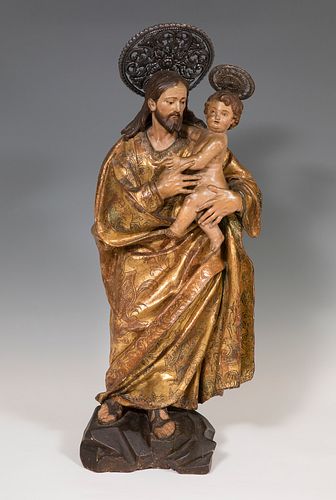Andalusian school; mid-eighteenth century. "Saint Joseph with Child". Carved and polychrome wood.
Lot 49
About Seller
Setdart Auction House
Carrer Aragó 346
Barcelona
Spain
Setdart Subastas was born in 2004 and is currently the first online art auction in Spain with solidity, prestige and reliability guaranteed by our more than 60,000 users. Setdart has a young, dynamic and enterprising team ready to successfully manage the purchase and sale of art works through custom...Read more
Categories
Estimate:
EUR€5,000 - EUR€6,000
$5,376.34 - $6,451.61
Absentee vs Live bid
Two ways to bid:
- Leave a max absentee bid and the platform will bid on your behalf up to your maximum bid during the live auction.
- Bid live during the auction and your bids will be submitted real-time to the auctioneer.
Bid Increments
| Price | Bid Increment |
|---|---|
| EUR€0 | EUR€10 |
| EUR€200 | EUR€25 |
| EUR€500 | EUR€50 |
| EUR€1,000 | EUR€100 |
| EUR€3,000 | EUR€200 |
| EUR€5,000 | EUR€500 |
| EUR€10,000 | EUR€1,000 |
| EUR€20,000 | EUR€2,000 |
| EUR€50,000 | EUR€5,000 |
About Auction
By Setdart Auction House
Nov 3, 2021
Set Reminder
2021-11-03 08:00:00
2021-11-03 08:00:00
America/New_York
Bidsquare
Bidsquare : OLD MASTERS
https://www.bidsquare.com/auctions/setdart-auction-house/old-masters-7786
Setdart Auction House sofia@setdart.com
Setdart Auction House sofia@setdart.com
- Lot Description
Andalusian school; mid-eighteenth century. "Saint Joseph with Child". Carved and polychrome wood. The powers are from a later period. Measurements: 94 x 38 x 23 cm. Until the Counter-Reformation, the most common thing was that the figure of St. Joseph remained in the background, since it was not given any theological importance. However, after Trent, his leading role as protector of Jesus during his childhood, as a guide during his youth, was recovered, and as such he is represented here. We see the two figures on the road, Joseph taking Jesus by the hand, a boy with blond curls and a rosy face, who looks at him smiling. Spanish Baroque sculpture is one of the most authentic and personal examples of our art, because its conception and its form of expression arose from the people and the deepest feelings that nested in it. With the economy of the State broken, the nobility in decline and the high clergy burdened with heavy taxes, it was the monasteries, the parishes and the confraternities of clerics and laymen who promoted its development, the works sometimes being financed by popular subscription. Sculpture was thus compelled to embody the prevailing ideals in these environments, which were none other than religious ones, at a time when the counter-reformist doctrine demanded from art a realistic language so that the faithful would understand and identify with what was represented, and an expression endowed with an intense emotional content to increase the fervor and devotion of the people. The religious subject is, therefore, the preferred theme of Spanish sculpture of this period, which in the first decades of the century starts from a priority interest in capturing the natural, to progressively intensify throughout the century the expression of expressive values, which is achieved through the movement and variety of gestures, the use of light resources and the representation of moods and feelings. Within this panorama, it is evident the role of first order that the Andalusian school of sculpture plays during the period developed a series of masters of unquestionable value who knew how to combine in their works the extraordinary technical quality and religious depth, in accordance with the environment of their time, fully connected with the tastes of the clientele, more interested in the work of religious themes than by the commissions of profane character, thus marking a substantial difference with respect to the production of other countries in Europe. Another differentiating aspect, although common with other national centers, is the material with which the works are made; the Andalusian sculpture is made of polychrome wood, a task of capital importance, since the final result of the work depends largely on it. The process had to be carried out by examined masters, and it could happen that the sculptor himself was also the painter. On the other hand, it is also worth mentioning that the economic development and the strength that Seville experienced after the Discovery, having become the gateway and port of the Indies, was quickly reflected in art; from the first decades of the century, masters of different origins began to constantly come to the city in search of the American market and the potential Sevillian clientele, increasingly attracted by the new artistic forms arriving from Italy. Italian, French and Flemish masters, with varying degrees of knowledge of the new aesthetics, alternate with artists from Castilian lands, who have also come into contact with the prevailing artistic currents in the Italian peninsula, thus becoming the most sought after in the art market. The teachings of all of them, together with the classical substratum inherent to the Andalusian culture itself, will constitute the foundations on which the Andalusian sculptural school will be built.
- Shipping Info
-
In-house shipping available. Please inquire at admin@setdart.com.
-
- Buyer's Premium



 EUR
EUR CAD
CAD AUD
AUD GBP
GBP MXN
MXN HKD
HKD CNY
CNY MYR
MYR SEK
SEK SGD
SGD CHF
CHF THB
THB















